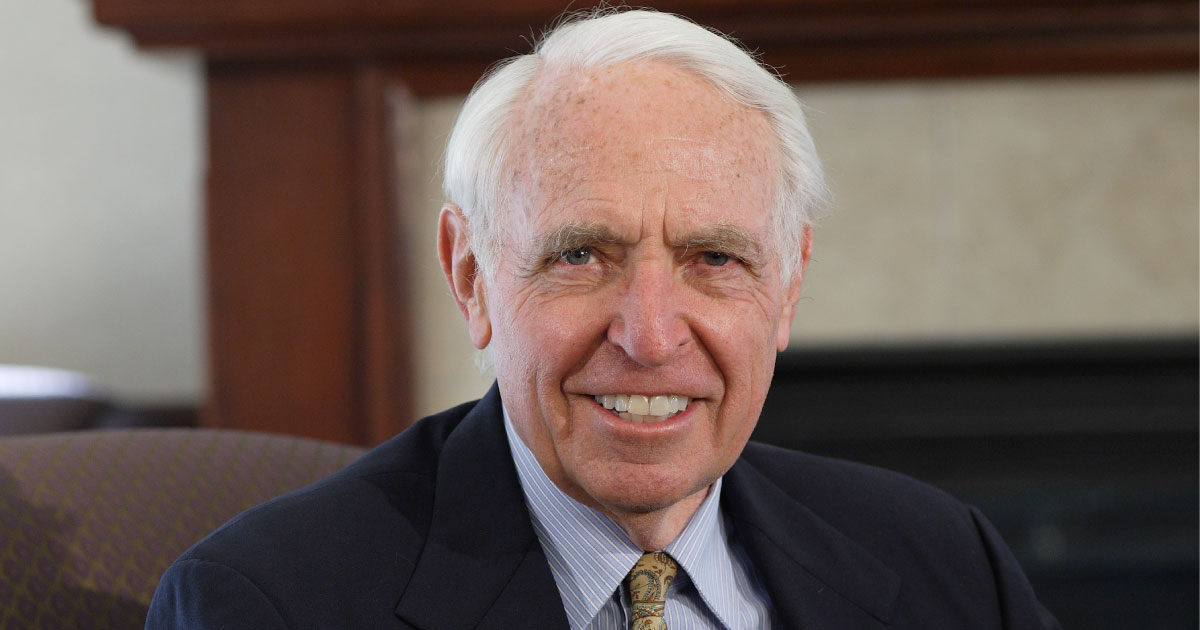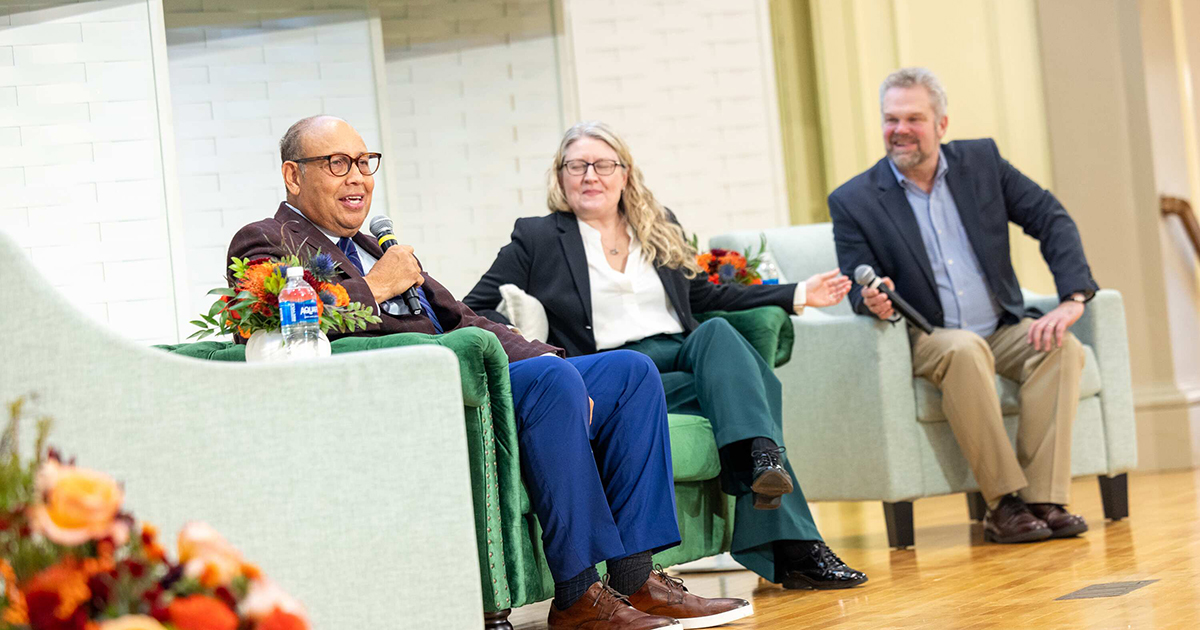Discover Babson’s Entrepreneurial History Through the Eyes of President Emeritus Sorenson

President Emeritus Ralph “Bud” Sorenson recently published his memoir: An Entrepreneurial Journey Through Life: Learning, Loving, and Laughing.
In An Entrepreneurial Journey Through Life: Learning, Loving, and Laughing, Sorenson shares his own experiences to illustrate an important truth: “being entrepreneurial” goes far beyond starting new businesses—though that is certainly a part of it. In fact, the entrepreneurial mindset applies to all aspects of life from choosing a career to finding a place to live, to making the most out of your retirement.
In the book, Sorenson devotes several chapters to his time as Babson’s president and captures many significant moments in the College’s history.
Join us on Friday, February 8, from 1:30 p.m. till 2 p.m. in the Reynolds Campus Center’s Babson Bookstore to meet Sorenson and to receive a signed copy of his memoir. The first 40 people to attend this event will receive one free copy. Can’t attend? You can order a copy of his memoir on Amazon.
Before you grab a copy, read on for excerpts from the book, published with President Sorenson’s permission.
I saw my role as that of helping to create a culture and vision for Babson that would bring out the best in everyone associated with the college and that would allow the college to make significant strides forward in achieving excellence in all that it did.
*********
Of all of the decisions embodied in the master plan, the one that had the greatest positive long-term impact on Babson, was that of identifying entrepreneurship education as an underserved area of management education.
At the time, very few business schools had courses aimed at helping to educate future entrepreneurs. The Harvard Business School, for example, had only a single elective course called “Management of New Enterprises.” It was not very popular with students. Instead, Harvard saw its greatest strengths in what it called the “general management” area. The faculty there was concentrating on preparing future captains of industry for what I was fond of calling the “giant generals”: General Motors, General Electric, General Foods, General Dynamics, General Tire and Rubber, etc. At the same time, they were also focusing on educating students [to] go to work for major consulting companies such as McKinsey and Booz, Allen and Hamilton or to head to Wall Street to become “Masters of the Universe” at investment firms such as Goldman Sachs, Morgan Stanley, and J.P. Morgan.
When I first arrived at Babson, some at the college were afraid that I might try to imitate HBS and “Harvardize” the place. This never entered my mind, since to try to compete directly with Harvard or some of the other top business schools would have been folly. Instead my thought was to identify an underserved niche that had potential and that would give Babson a distinctive competitive advantage.
My tenure as Babson’s president was the single most fulfilling period of my professional career.
Ralph “Bud” Sorenson, Babson President Emeritus
During my early weeks as president when I immersed myself into trying to learn everything possible about Babson, I made it a point to study what past graduates of the school had done with their careers. When looking through the alumni catalogue, I began to notice that a large number of graduates had the title of “president” or “founder” or “CEO” after their names. Typically, however, they were not large companies or organizations that they were heading. Instead, they tended to be the self-employed heads of small enterprises such as car dealerships, retail establishments, accounting firms, construction companies, small manufacturing firms, etc. In many cases, they were companies they had started themselves or that had been started by their families. That was when the light bulb went on in my head. Why shouldn’t Babson pick as its niche an explicit focus on entrepreneurship education?
This idea was reinforced in the planning process by several faculty members, and in particular, Professor Jack Hornaday, who was already teaching a course in entrepreneurship and who thought that such a focus made sense for a variety of reasons. First, it built on an historical tradition already in place at Babson. Second, there were no other business schools with such a specialty. Third, such a focus had a good chance of winning the support of most of the management faculty, regardless of their functional area focus. Entrepreneurship education would require good marketing professors, finance professors, operations professors, organizational behavior professors, business policy professors, etc. Thus, it wouldn’t lead to a situation such as existed at other business schools where one functional area often tended to overshadow the others; for example: finance at Wharton, marketing at Northwestern, general management at Harvard. This functional focus, in turn, sometimes resulted in internal rivalries and unhealthy faculty pecking orders at these institutions. To the greatest extent possible, we hoped to avoid such rivalries at Babson.
The final reason for focusing on entrepreneurship was perhaps the most important one. Namely, as the master planning task force thought about the future and the needs of the coming decade, we concluded that there would be an expanding need for growing numbers of entrepreneurs capable of creating new enterprises that, in turn, would be the source of jobs, new inventions and innovations, and additional wealth. We also were convinced that, while many believe that entrepreneurs are born and not made, there was much that we could teach those with the entrepreneurial gene that would significantly increase the odds that they would be successful when the time came for them to actually start a new enterprise.
Hence, we determined to try to develop entrepreneurship education as a major focus of the school. Toward that end, we created the first Center for Entrepreneurship Education in the world. The Center, as it developed, encompassed a whole suite of activities.
First, it involved the development of more courses in entrepreneurship at both the undergraduate and graduate MBA levels, together with offering entrepreneurship as a Major in both programs.
Second, it led to the eventual creation of the Symposium for Entrepreneurship Educators at Babson. This was a short, non-degree outreach program designed to enhance Babson’s impact on entrepreneurship education by teaching professors at other business schools how better to teach entrepreneurship. This program was very practical in nature and had as its mission to teach its participants very specific classroom skills. Its design was unique. One week in length, its applicants applied to the program in pairs in which one participant was a faculty member experienced in teaching and the other was an experienced entrepreneur who was interested in sharing his or her “real world” experiences with others by becoming a practitioner teacher. The symposium has proven to be immensely successful and is still in existence decades later. Its alumni roster now includes thousands of teachers of entrepreneurship, many of whom are continuing to teach at business schools all around the world.
A third activity of the Center for Entrepreneurship was its creation and sponsorship of an annual research conference at which scholars and researchers doing work in the field of entrepreneurship were invited to submit and present the results of their work to their academic peers. Again, this conference still exists and has become the premier conference of its type in the academic world.
Finally, we created the “Academy of Distinguished Entrepreneurs.” This was an effort to give long overdue public recognition to successful and innovative entrepreneurs from around the world. It was also intended to draw attention to the fact that Babson was staking out a claim to be a leader in the field of educating future entrepreneurs. At the time, a number of business schools and business publications had various “hall of fame” programs to honor outstanding CEOs of large companies and to give recognition to various successful Fortune 500 Companies. But no programs existed to pay homage to outstanding entrepreneurs who had been successful at creating jobs, innovative new businesses, and wealth.
********
The Academy helped put Babson on the map and symbolically announced to the world that Babson was on the move and was carving out a niche in entrepreneurship education. During my subsequent tenure as president at Babson, the annual Academy ceremonies were a highlight of each year for students, faculty members, judges, and leaders of the Boston business community alike. And no one enjoyed both the annual judging lunches and the yearly induction ceremonies more than me.
My tenure as Babson’s president was the single most fulfilling period of my professional career. I loved my job, believed in the mission of the college, and felt that what I was doing was making a positive difference. It was not totally a seven-year honeymoon, but it came very close to it.
Posted in Community





